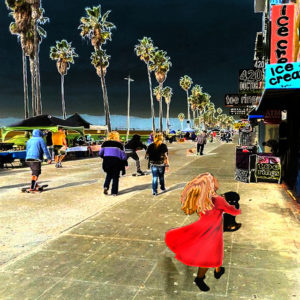
This makes the City’s repeated assertion throughout tonight’s filing that the Boardwalk is a public park particularly galling. If it’s an error, it’s careless beyond belief. The principle of charity compels me to assume it’s more of the dark sarcasm so favored by Feuer’s minions. They just don’t give a fuck, and why should they? They probably already have the million dollar payout to Carol Sobel budgeted for. But I’m getting ahead of the story.
Here’s the deal: the plaintiffs’ opposition to the motion to dismiss is based explicitly and repeatedly on the fact that the Boardwalk is a sidewalk:
The Venice Boardwalk was deeded to the City in perpetuity as a sidewalk and has been used for that purpose as a pedestrian thoroughfare for more than a century. Public sidewalks are, historically, the traditional public forum open and available to all without concern for closing streets or reserving park space for competing users. Plaintiffs have a right to engage in core expressive activity on a public sidewalk. Indeed, “a sidewalk is the ‘prototypical’ traditional public forum.” Marcavage v. City of New York, 689 F.3d 98, 104 (2d. Cir. 2012).
See how the plaintiffs’ claim actually distinguishes between expressive activity on sidewalks and (presumably) more restrictable expressive activity in parks, of which the Boardwalk is not an example. So when the City makes claims like the following, it’s almost like they didn’t read the pleading to which they’re putatively responding:
Additionally, Plaintiffs’ opposition focuses on the fact that the Venice Beach Boardwalk is a quintessential public forum—a public park—where a speaker’s First Amendment protections reach their zenith. But contrary to Plaintiffs’ assertions, public parks are not exempt from narrowly-tailored restrictions on protected speech or conduct. In Clark, the Supreme Court upheld the government’s prohibition on camping and sleeping in certain parks because it “narrowly focuses on the Government’s substantial interest in maintaining the parks in the heart of our Capital in an attractive and intact condition, readily available to the millions of people who wish to see and enjoy them by their presence.”
…
Similarly here, the City has an interest in maintaining its public park in an attractive, clean, and safe condition, and ensuring that Designated Spaces are readily available to people who wish to use them on a first-come, first-served basis at 9:00 a.m. Allowing people to set down items indefinitely, or even overnight, in Designated Spaces would be inimical to those interests.
And then there’s the snarky tone in remarks such as the following footnote, in which the City presumes to suggest that it would be more effective to protest police brutality by attending neighborhood council meetings than by leafletting. I’ve long thought that one of the uses the City has for neighborhood councils is to defuse dissent by providing a endless black hole into which civic-minded citizens can effectlessly pour their time and energy, and this remark certainly doesn’t make me want to rethink anything:
Interestingly, Plaintiffs claim they want to target “local Venice residents” for their message, but they do not explain how they would be able to differentiate locals from the millions of tourists who flock to the boardwalk each year. Plaintiffs would probably be
more effective in reaching their intended audience by attending Neighborhood Council meetings and/or canvassing door-to-door.
Of course, I’ve only touched on one aspect of the City’s response, so you should definitely read it yourself and form your own opinion. To me, though, it looks like another phone-it-in performance from the burnt-out cases chained up in Feuer’s attic at 200 N. Main Street that’s going to result in yet another seven figure payout to Carol Sobel, kein ayin hora.
Ice Cream on the Boardwalk is released by its creator garlandcannon under the CC BY 2.0.
